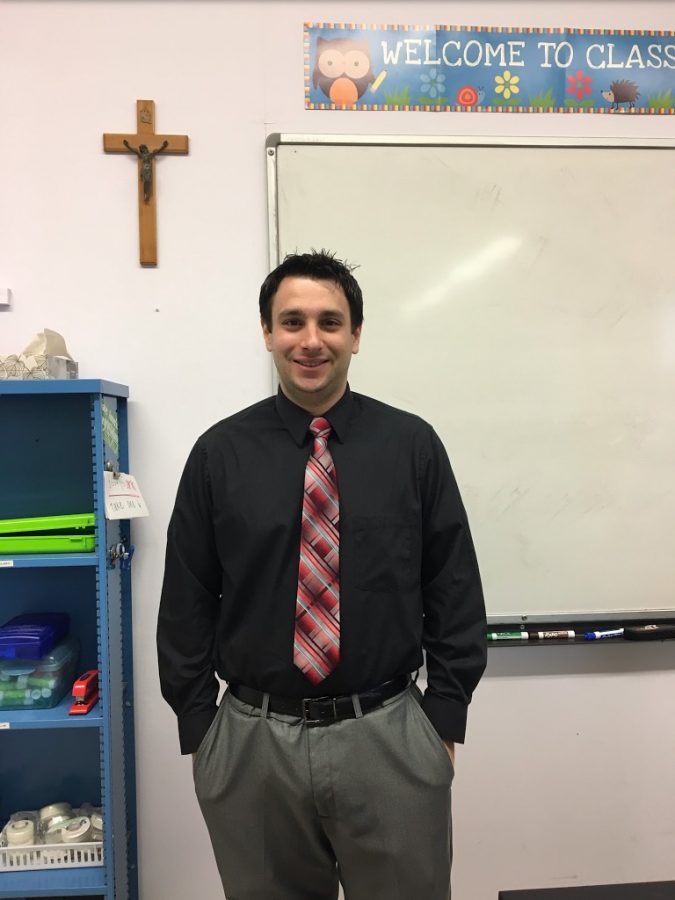Course Spotlight: Anatomy and Physiology
October 19, 2017
This year, there is an exciting new addition to the science department – the Anatomy and Physiology course taught by Mr. Tassone. A familiar face in the Naz hallways, Tassone started his tenure at Nazareth as a long-term substitute for Biology classes during the 2016-2017 school year.
The Announcer conducted an interview with Mr. Tassone in hopes to gather more information about this new and exciting course:
Bridget Lockie (BL): What is the difference between the Honors Anatomy and Physiology class and the Biology courses at Nazareth?
Mr. Tassone (MT): Biology courses are designed to study all forms of life, such as prokaryotes and plants. Biology also touches on many other subjects such as genetics, evolution, the history of life, cell respiration, photosynthesis, and photogenic trees. Anatomy and Physiology deals with none of the concepts that I just mentioned. Anatomy and Physiology is different because it strictly looks at the structure and function of different cells, tissues, organs, and organ systems within the HUMAN body. Anatomy and Physiology will deal only with HUMAN anatomy, this course is not concerned with anything else. Anatomy and Physiology also focuses very heavily on homeostasis (maintaining a stable state). Anatomy and Physiology also uses a common language, meaning that if you learn the Latin/Greek names for different parts of the body, those terms will be the same no matter where you travel in the world. This is so that all doctors have a common reference point from which to work.
BL: Who’s idea was it to add this course to the science curriculum?
MT: Both the administration and science department were looking to add this course.
BL: What topic/chapter are you most excited to teach?
MT: Personally, I enjoy the muscle system and nervous system. While both systems are very difficult, they underlie much of what we are able to do in our lives. The muscle system allows for movement via the contraction of the muscles. The nervous system shows us how we are able to respond to different stimuli and how our brain commands different parts of the body.
BL: Is an Anatomy and Physiology course common in most high schools?
MT: Yes, normally most high schools will offer an Anatomy and Physiology course (usually to Juniors or Seniors).
BL: Do you enjoy teaching Anatomy and Physiology or Biology more?
MT: I like teaching both subject materials equally. I enjoy being able to explain why our bodies work in the ways that they do. Both subjects allow me to do this. However, in Anatomy, I am able to talk more about the different types of diseases that arise when the body falls out of homeostasis (so maybe I’d lean towards Anatomy). I greatly enjoy pathology (the study of diseases) so this is something that I enjoy teaching about in Anatomy.
BL: Did you take an Anatomy and Physiology course while you were in school? If yes, what is it like compared to Naz’s?
MT: I took Anatomy and Physiology when I was in college. In comparison, the material that we are covering is the same. However, the major exception is that the college courses go into much greater depth of detail. In the college courses, I had lectures three times a week, and lab twice a week. Much of my free time was devoted to studying and reviewing the material in order to keep up with the pace of the course.
BL: How many students are taking this course at Naz?
MT: There are 44 students total.
BL: What’s a simple explanation of what this course covers/focuses on?
MT: Simply, Anatomy and Physiology studies the structure and function of the human body. It focuses on learning first how to identify parts of the body, then the different types of cells in the body, and then covering all the different body systems (skin, muscle, nervous, endocrine, reproductive, etc).

